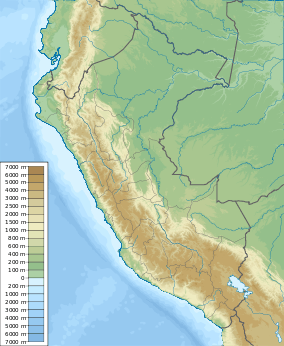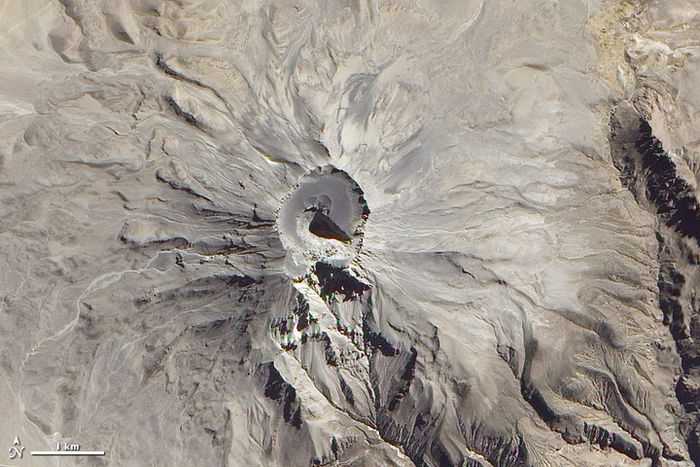Ubinas
| Ubinas | |
|---|---|
 Ubinas Volcano seen from the west | |
| Elevation | 5,672 m (18,609 ft)[1] |
| Location | |
 Ubinas | |
| Location | Moquegua Region, Peru |
| Range | CVZ, Andes |
| Coordinates | 16°21′18″S 70°54′11″W / 16.35500°S 70.90306°WCoordinates: 16°21′18″S 70°54′11″W / 16.35500°S 70.90306°W[1] |
| Geology | |
| Type | Stratovolcano |
| Last eruption | September 3, 2013[1] |
Ubinas is Peru's most recently active volcano. Until 2006, this stratovolcano had not erupted for about 40 years.
Description
Ubinas is located in southwestern Peru. The upper slopes of the volcano, composed primarily of Pleistocene andesitic lava flows, steepen to nearly 45 degrees. The steep-walled, 1.4 km wide and 150 m deep summit caldera contains an ash cone with a 500-m-wide funnel-shaped vent that is 200 m deep. Debris-avalanche deposits from the collapse of the SE flank of Ubinas extend 10 km from the volcano.
The volcano is a composite cone built on a high plateau formed from Oligocene-Miocene (Neogene) ignimbrites and intrusive rocks. Ubinas comprises two edifices that divide two major periods of its eruptive behaviour. The first is the lower volcano under 600 m high called Ubinas 1 (eruptive period >376 ka), which collapsed and formed a debris-avalanche deposit as far as 12 km downstream Rio Ubinas. This collapse was followed by an eruption of non-welded ignimbrites, ponding to a thickness of 150 m over 5 km from the summit, and in turn was covered by a 100 m thick ash/pumice deposit. Ubinas 1 is overlain by a steeper cone more than 900 m high called Ubinas 2 (eruptive period <376 ka). Ubinas 2 formed the summit caldera, with walls up to 300 m high that consist of hydrothermally altered lava flows and floored by a 20 m thick pile of lapilli and ash-fall layer. This morphology was created by frequent eruptions in the Late Holocene from the younger inner crater. The inner crater is under 200 m high and shows pervasive hydrothermal alteration and abundant fractures. Countless explosive events have taken place inside the summit caldera during the last 9.7 ky, and it has been suggested by Thouret et al. that the caldera be considered gravitationally unstable.[2]
-

Ash cloud from Ubinas, viewed from the ISS, 14 August 2006
-

True-colour satellite image of Ubinas
Geologic setting
Ubinas is located 230 km east of the Peru-Chile trench and about 150 km above the Benioff-Wadati plane, where the Nazca plate is subducting at a dip ranging from 20 – 30˚ as characteristic of the CVZ. The steep dip angle of the subducting plate can correspond to a thicker wedge of asthenosphere and therefore a greater source of fertile mantle material. Some volcanologists believe that this variation in dip angle along the Nazca Lines is responsible for activity in the Andean volcanic zones and the areas of inactivity in between them.[3]

History
There are at least two Plinian deposits, reflective of explosive eruptions with more differentiated magmas. The latest such eruption occurred between 1000 and 1160 A.D., producing an andesitic pumice-fall deposit which achieved a thickness of 25 cm over 40 km from the summit. Smaller eruptions since have also shown a wide range in composition from mafic to rhyolitic, which may indicate that magma mixing is occurring in the feeding magma chamber. Because it is.
Activity update
As of April 22, 2006, the volcano is erupting with fumaroles and ash plumes. [4]
On April 23, 2006, Peru declared a state of emergency in towns near the volcano.
See also
References
- ↑ 1.0 1.1 1.2 "Ubinas". Global Volcanism Program, Smithsonian Institution. http://www.volcano.si.edu/world/volcano.cfm?vnum=1504-02%3D.
- ↑ Thouret et al., 2005, Ubinas: the evolution of the historically most active volcano in southern Peru., Bull Volcanol, 67, p. 557-589
- ↑ Winter, J. D., 2001. An Introduction to Igneous and Metamorphic Petrology. Prentice Hall Inc., Upper Saddle River, New Jersey
- ↑ "Volcano prompts state of emergency". CNN (via Internet Archive). Archived from the original on 2006-04-24.
External links
| |||||||||||||||||